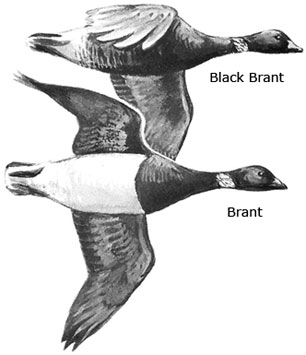Wildlife - Species

Species Specific Regulations
Brant
Licenses: Hunting License required. Migratory Bird Hunting and Conservation Stamp (Federal Duck Stamp) that is validated by the hunter signing the stamp in ink across the face of the stamp
Limits: Please see Migratory Bird Regulations for any game zones restrictions or Limitations.
Brant (Branta bernicla)

Description
This small goose has a black head, neck and chest with a partly broken white color.
Average Size
Brant have an average length of 24-25 inches and an average weight of 3 1/4 - 3 3/4pounds.
Range
While brants are found in all four flyways they are the most common along the coast. Brants are extremely rare visitors to South Carolina during the winter months.
Preferred Habitat
Brants nest in the low arctic, often along the edge of salt marshes and estuarine deltas. During the winter months they move to protected coastal habitats, such as intertidal mudflats and, sheltered estuaries, and in shallow waters behind barrier islands.
Food Habits
During the breeding season brants consume mostly graminoids, forbs, and mosses. In the winter months their diet shifts to eelgrass, green algae, salt marsh plants, and they are even known to graze in grasslands.
Reproduction
These geese arrive on the breeding grounds already paired. They nest in low, grassy vegetation near the coast and sometimes on islands. The female builds the nest by removing soil until she reaches the permafrost, about 2 to 4 cm down. Then she lays 3-5 light buff eggs.
Sound
Both sexes make a guttural cronk and a cut cu cut cronk.
Behavior
- During the breeding season males are more aggressive than other geese.
- Often breeds colonially in the low arctic, but rarely breeds colonially in the high arctic.
- Often forms large flocks in the winter months.
- Does not usually form mixed flocks.
Citations, Publications and Literature
U.S. Fish & Wildlife Service, Federal Duck Stamp Office Presents: North American Waterfowl (Adobe PDF file)
Reed, A., D. H. Ward, D. V. Derksen and J. S. Sedinger. 1998. Brant (Branta bernicla), The Birds of North America Online (A. Poole, Ed.). Ithaca: Cornell Lab of Ornithology; Retrieved from the Birds of North America Online
South Carolina waterfowl hunters 16 and older are required by state law to obtain a state migratory waterfowl permit and Migratory Game Bird permit. Both permits must be in the hunter's possession while hunting or transporting legal waterfowl. A state waterfowl permit is included with the Lifetime Senior, Lifetime Gratis and Disability Licenses. S.C. residents who hold a Lifetime Senior or Lifetime Gratis License are not required to have a Migratory Game Bird permit.
National Migratory Bird Harvest Information Program (HIP)
The waterfowl permits and HIP permits are available from select DNR offices and from hunting and fishing license agents.
